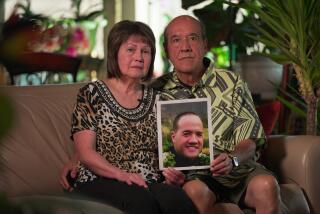A short trip from fatigue to felony
- Share via
In the early morning of Aug. 8, 2004, Jonathan Wallace, 19, was sound asleep in a vehicle that veered off Interstate 80 in Northern California, struck two trees and flipped over.
Although the 6-foot-7, 200-pound college honor student and basketball player was wearing his seat belt, the powerful crash ejected him from his front passenger seat, according to a Placer County coroner’s report on the accident.
The Oakland teen was pronounced dead at the scene. Another passenger in the vehicle suffered serious injuries and was airlifted to a hospital.
It turned out Wallace wasn’t the only one to fall asleep in the car on the ride home from Reno. According to the coroner’s report, driver Craig Berry told the CHP that the crash occurred when he fell asleep at the wheel. Berry had reportedly been up for 18 hours before the crash, says the Rev. Michael Wallace, Jonathan’s father.
Statistics from the National Highway Traffic Safety Administration show that at least 100,000 crashes and 1,500 deaths are caused by drivers falling asleep at the wheel each year. The Automobile Club of Southern California estimates that at least a third of all accidents in the U.S. involve drowsy driving.
A poll conducted in 2002 by the National Sleep Foundation in Washington, D.C., found that 100 million motorists -- about half of American adult drivers -- drive while drowsy, according to spokeswoman Marcia Stein.
Nearly two out of 10 drivers in the poll admitted to actually having fallen asleep behind the wheel, says Stein.
“Fatigued driving is not a new revelation. It has been claiming precious lives for decades,” says Rita Monroe of Victims of Irresponsible Drowsy Drivers, a New York nonprofit organization dedicated to educating the public and pushing for tough laws on the issue. Monroe’s daughter was killed in a 1993 accident, by a driver who was short on sleep.
New Jersey is the only state that has passed legislation directly addressing the hazards of drowsy driving. “Maggie’s Law,” passed in 2003, establishes that falling asleep at the wheel can be viewed as reckless driving under the state’s existing vehicular homicide statute. The law was passed in honor of Maggie McDonnell, a 20-year-old college student who was killed in 1997 in a head-on collision. The driver of the other vehicle told New Jersey police that he hadn’t slept for 30 hours.
The New Jersey legislation defines “fatigue” as being deprived of sleep for more than 24 consecutive hours. In such a case, a motorist who falls asleep at the wheel and kills someone can be charged with vehicular homicide and face up to 10 years in prison and hefty fines.
Passage of the New Jersey law led Michigan, Maryland, Massachusetts and New York to introduce similar bills, none of which has yet passed.
Prosecutors in states that don’t have specific drowsy-driving legislation are already tackling the problem by charging drivers who have caused such accidents with offenses such as manslaughter or reckless driving, says Darrell Drobnich, senior director of government affairs at the National Sleep Foundation in Washington, D.C.
Late-night shift workers, people with sleeping disorders, truck drivers, doctors and other hospital employees, sleep- deprived students and even those in the entertainment industry have struggled to keep awake after a long night or early morning shift.
Stein says the producer of an early morning television show once told her that she “liked to hit red lights so she could take a quick nap.” It’s called “micro sleep,” says Stein.
As the number of vehicles on the road increases nationwide and “our 24-hour world” grows increasingly demanding, “Americans are sacrificing their sleep, risking the lives of others,” says Stein.
A Harvard University Medical School study, published in the January issue of the New England Journal of Medicine, indicates that tired drivers can be just as dangerous as drunk drivers on the road.
The study tracked vehicle accidents among 2,737 hospital interns nationwide and found that those who worked shifts that were 24 hours or more increased their risk of an accident by 167% over motorists who had had a night’s sleep, according to Charles A. Czeisler, head of the Division of Sleep Medicine at Harvard Medical School.
The auto industry is also looking at the issue. Infiniti recently unveiled a lane-departure warning system on the FX45 designed to help drowsy drivers from drifting out of lanes and causing an accident. The system warns the driver when the car begins to drift out of its lane without a turn signal. Ford is also working on such a system. Such safeguards have been available for years in Japan.
In the meantime, Monroe and experts at the Sleep Foundation believe public awareness and education campaigns similar to national anti-drunk-driving campaigns are needed to get out the message.
“Drowsy drivers need to be held accountable if they kill or injure people,” says Michael Wallace.
He says no charges were filed against the driver who fell asleep in his son’s accident. “He didn’t even lose his driver’s license.”
Jeanne Wright can be reached at jeanrite@aol.com.






